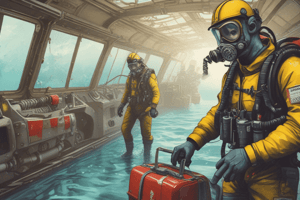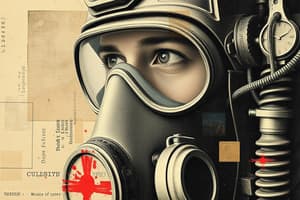Podcast
Questions and Answers
What are the three things that must be present at the same time to produce the chemical reaction that is fire?
What are the three things that must be present at the same time to produce the chemical reaction that is fire?
- Oxygen, Water, Fuel
- Oxygen, Heat, Wood
- Oxygen, Heat, Fuel (correct)
- Heat, Water, Fuel
What does the fire triangle consist of?
What does the fire triangle consist of?
Oxygen, Heat, Fuel
What are some things that produce heat?
What are some things that produce heat?
Static electricity, friction, chemicals that react with one another.
What are the fuel classifications that need to be known for correctional professionals?
What are the fuel classifications that need to be known for correctional professionals?
What must be on fire to be considered a 'Class A' fire?
What must be on fire to be considered a 'Class A' fire?
What is the most common type of fire?
What is the most common type of fire?
What fire class is represented by an icon of a trash bin?
What fire class is represented by an icon of a trash bin?
What must be on fire to be considered a 'Class B' fire?
What must be on fire to be considered a 'Class B' fire?
What must be on fire to be considered a 'Class C' fire?
What must be on fire to be considered a 'Class C' fire?
Class C fires can change class by what action?
Class C fires can change class by what action?
What icon represents a 'Class C' fire on fire extinguishers?
What icon represents a 'Class C' fire on fire extinguishers?
What must be on fire to be considered a 'Class D' fire?
What must be on fire to be considered a 'Class D' fire?
What type of fire is a Class K fire?
What type of fire is a Class K fire?
How do portable fire extinguishers work?
How do portable fire extinguishers work?
What are the three most common types of fire extinguishers?
What are the three most common types of fire extinguishers?
Why are air-pressured water extinguishers the least common?
Why are air-pressured water extinguishers the least common?
What is the most common type of fire extinguisher?
What is the most common type of fire extinguisher?
What do Carbon Dioxide fire extinguishers do?
What do Carbon Dioxide fire extinguishers do?
Why are Dry Chemical extinguishers so effective?
Why are Dry Chemical extinguishers so effective?
Flashcards are hidden until you start studying
Study Notes
Fire Triangle Components
- Three elements necessary for fire: Oxygen, Heat, and Fuel.
- Oxygen must be in sufficient quantity to sustain combustion.
- Heat must reach the ignition temperature for a fire to start.
- Fuel refers to any combustible material available for burning.
Fire Classifications
- Class A: Involves ordinary combustibles like wood, paper, cloth, and trash, produces ash when burned.
- Class B: Consists of flammable liquids and gases, including gasoline, oil, and propane.
- Class C: Pertains to energized electrical equipment, can change class if unplugged from the power source.
- Class D: Involves combustible metals, such as magnesium and sodium, requires specific extinguishing agents.
Class Fire Icons
- Class A fires represented by a trash bin icon due to common combustible materials.
- Class C fires denoted by electrical outlet imagery on extinguishers.
Special Fire Classes
- Class K fires, also known as Kitchen fires, addressed primarily in kitchen settings, especially for fryer fires.
Fire Extinguisher Mechanics
- Portable fire extinguishers function by removing oxygen, smothering flames, or reducing heat.
- Common Extinguisher Types:
- Water extinguishers are effective solely on Class A fires.
- Carbon Dioxide (CO2) extinguishers control both Class A and B fires; they can cool the fire and displace oxygen.
- Dry Chemical extinguishers are versatile, effective on Classes A, B, and C.
Extinguisher Effectiveness
- Air-pressured water extinguishers are the least common due to safety concerns with flammable and electrical fires.
- CO2 extinguishers cool flames and replace oxygen but may allow Class A fires to reignite due to insufficient oxygen removal.
- Dry Chemical extinguishers are widely used for their ability to combat multiple fire classes effectively.
Studying That Suits You
Use AI to generate personalized quizzes and flashcards to suit your learning preferences.




